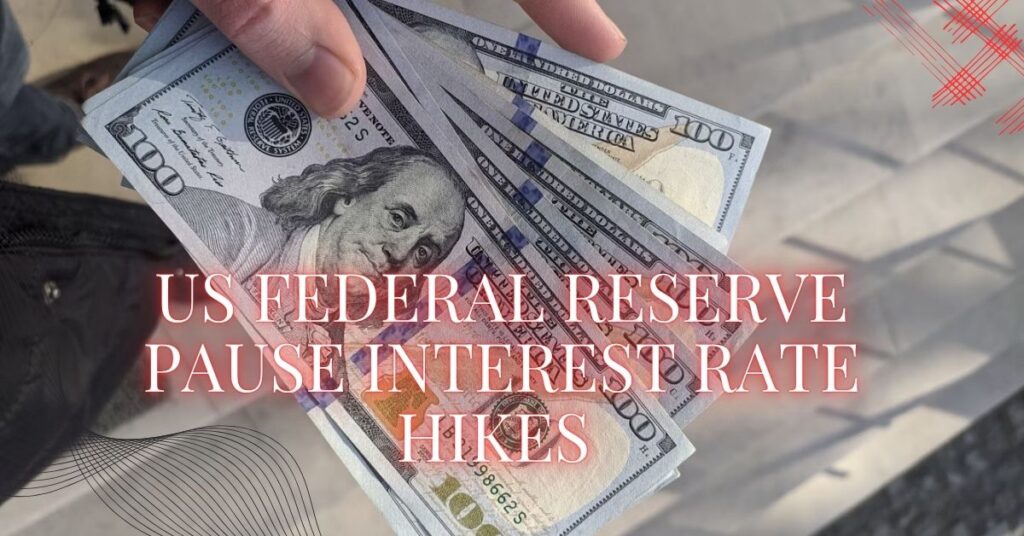In a highly expected policy move, the United States Federal Reserve chose to pause interest rate hikes in July 2025, keeping the federal funds rate unchanged at 5.25% to 5.50%. This decision marks a significant moment in the Fed’s ongoing efforts to balance economic growth with price stability after more than two years of aggressive rate increases aimed at curbing post-pandemic inflation.
As the financial world reacts, this decision is already influencing global market sentiment, capital flow trends, currency exchange dynamics, and investor behavior.
Why the Federal Reserve Paused Interest Rate Hikes in July 2025
The Federal Open Market Committee (FOMC) voted to pause its rate increases in a move that reflects its concern over slowing economic momentum amid persistent core inflation. While headline inflation has declined significantly since its 2022–2023 highs, core inflation remains above the Fed’s 2% target, especially in key segments such as services, housing, and healthcare.
Key Economic Indicators Behind the Fed’s Decision:
- Core inflation remains elevated at approximately 3.1%
- The US unemployment rate rose to 4.2%, signaling a cooling job market
- Retail sales declined for two consecutive months in Q2 2025
- Mortgage applications and credit growth have contracted sharply
- Manufacturing output slowed in both May and June 2025
During the post-decision press briefing, Fed Chair Jerome Powell emphasized that this pause does not signal the end of the tightening cycle. “We remain data-dependent,” Powell said. “Further rate increases remain possible if inflation proves sticky.”
Nonetheless, many economists now believe the Fed is approaching or has reached its terminal interest rate—unless unexpected inflation surprises emerge later in the year.
Global Implications of the US Fed Rate Pause in July 2025
The global impact of the Fed’s interest rate decisions is far-reaching due to the dominant role of the US dollar in international finance and the size of the US economy. The July 2025 pause is already influencing financial conditions around the world.
1. Emerging Markets Gain Breathing Room
For emerging markets—particularly in Latin America, Southeast Asia, and Africa—the Fed’s pause offers a welcome reprieve. These nations have long struggled to maintain currency stability while also sustaining economic growth in the face of rising US rates.
Benefits observed:
- Improved foreign capital inflows
- Currency stabilization relative to the US dollar
- Greater policy flexibility to focus on domestic economic priorities
This environment lowers the risk of capital flight—a common challenge during periods of US monetary tightening when investors shift toward higher-yielding, safer US assets.
2. Currency Markets Adjust to a Softer Dollar
Following the Fed’s announcement, the US dollar weakened slightly against major global currencies, including:
- Euro (EUR)
- British Pound (GBP)
- Japanese Yen (JPY)
Effects of a softer dollar:
- Lower import costs for developing countries
- Easier debt servicing for nations with dollar-denominated loans
- Improved trade balances globally
This change benefits countries whose economies are vulnerable to strong dollar fluctuations and provides relief to multinational corporations with global exposure.
3. Commodities and Energy Markets Show Optimism with Caution
Traditionally, a weaker US dollar boosts commodity prices, and early market reactions followed suit:
- Brent crude oil climbed by 1.2%
- Gold prices rose by 0.9%
However, energy and commodity traders remain cautious due to:
- Volatile demand from China, a major global commodity consumer
- Geopolitical instability, particularly in Eastern Europe and the Middle East
- Unpredictable inventory and supply chain conditions
4. Global Equity Markets React Positively to Policy Stability
Equity markets worldwide responded favorably to the perceived stability and clarity in US monetary policy:
- Asian stock indices rose, led by gains in technology and consumer sectors
- European benchmarks like the FTSE 100 and DAX recorded modest gains
- In the US, the S&P 500 and Nasdaq Composite continued upward momentum as Treasury yields fell
The Fed’s decision has lowered short-term volatility and encouraged investors to return to riskier assets, including growth stocks and international equities.
5. Bond Markets Strengthen as Yields Decline
The yield on 10-year US Treasury notes fell to 3.92%, causing bond prices to rise.
Investor responses include:
- Greater interest in emerging market sovereign bonds
- Renewed demand for Eurozone bonds amid lower US yield competition
- Increased attractiveness of corporate bonds in tech and healthcare
Lower yields also improve financing conditions for governments and corporations worldwide.
Risks and Uncertainties: Why This May Be Just a Pause, Not a Pivot
Despite the positive reaction, the pause in rate hikes by the Federal Reserve doesn’t eliminate major risks to the global economy and financial markets.
Key Downside Risks to Monitor:
- Persistent inflation in services and energy
- Weak consumer confidence in both the US and Europe
- Ongoing supply chain disruptions driven by geopolitical tensions
- Potential reacceleration of inflation in Q4 2025, particularly if oil prices spike
Central banks globally—including the European Central Bank (ECB) and the Bank of England (BoE)—will continue to proceed cautiously, influenced by domestic inflation data and external economic shocks.
Key Events to Watch in the Coming Months
Next Federal Reserve Meeting – September 2025
Investors and analysts will closely monitor the September FOMC meeting for clues about whether this is the start of a pivot or a temporary pause.
US Inflation Reports – CPI and PCE
- Consumer Price Index (CPI)
- Personal Consumption Expenditures (PCE) Core Inflation
These indicators will shape the Fed’s outlook on inflation and future rate moves.
Global PMIs (Purchasing Managers’ Indices)
Q3 manufacturing and services PMI data will reveal whether the global economy is gaining strength or entering another slowdown.
Responses from the ECB and BoE
Both central banks will watch how the Fed’s pause influences currency dynamics and inflationary trends in their own economies before deciding on rate policy shifts.
Conclusion: Has the Fed Reached Its Peak Rate or Is It Just Taking a Breather?
The Federal Reserve’s decision to hold interest rates steady in July 2025 is a pivotal development in this tightening cycle. While it signals a shift in tone, it does not necessarily mark a full pivot toward rate cuts or monetary easing.
For global markets, especially emerging economies, the pause offers short-term stability and policy flexibility. It also reduces pressure on currencies, debt markets, and cross-border trade dynamics.
However, investors must remain vigilant. The macroeconomic outlook remains fragile, and future Fed actions will be heavily influenced by inflation data, labor market conditions, and geopolitical developments.








